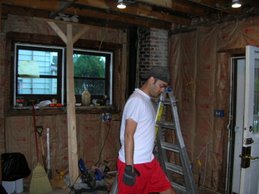Is it solely the architects that are responsible for the inequalities that were described in the article? I would argue that it is not, there are many contributing professions/factors that are to blame; society, urban planners, money, politicians and numerous others.
Cookie cutter suburbs can be partially atributed with the development of transportation (i.e. highways, automobiles, etc). As highways and mass transit developed, it allowed the oppurtunity for a family to move away from the city and take up residence in these areas. With the mass migration to the suburbs, cities often were vacated after the workday. Thus hurting businesses that stayed open past 5pm. Many downtown areas often suffered from a lack of activities to attract people back to the downtown areas.
An example of a recent suburb that has attracted a lot of attention in this area is New Albany, Oh. This could be considered an example of an upscale "gated community." A wealthy businessman in Columbus, bought farm land and turned it into his own "Georgian Utopia." The community, is fairly new and is dominated by brick georgian homes, owned by many wealthy businessman who commute to and from work on the interstate. This community is self-sufficient, including a campus with an elementary, middle and high school, a local shopping area and a clubhouse and championship golf course where no doubt many deals are done.
In my opinion, the power currently resides in the hands of the wealthy developers who have the money and influences/power to educate the masses in what"good design citizenship" is. In many instances, it seems that the architect becomes an afterthought in the design stages, since, the design intent is usually determined before an architect is even chosen.
Subscribe to:
Post Comments (Atom)

5 comments:
Hi Joe!
New Albany is a strange place - it can't really decide what it wants to be. Its brick and georgian and wants to be historic, and then just a block down the road are endless white "farm fences" that makes one think New Albany is Green Acres with rolling hills. It has seen so much growth that it is hard to imagine that continued growth is sustainable, specifically on its small town resources like fire, police, schools, doctors, dentists, not to mention the strain on roads, water, sewer, natural gas - I think you can see that I agree with almost all of your points! However, New Albany is its own town; like Powell, due to its "proximity" to Columbus (which I think is relative - please don't ask me to drive to Powell or New Albany at 5pm!) it has become a sort of satellite city. As you said, developers latched on to the area and basically hand selected the demographic - I have no doubt that the architect was the afterthought.
Joe, no question that, on the whole, builders and developers drive the housing market with little input from Architects except where required....this is telling though, because, as anyone who has ever worked with a builder or developer can attest, they are customer driven.....if the market wants a certain type of house or neighborhood, the developer will accomodate.....only once the mindshift of the market changes will the developers product follow..
"field of dreams".....you build it and they will come. With Bexley and Upper Arlington land locked. Dublin now old school, Powell and New Albany are now the new fields. New Albany is definitely self- suficient now that they have their own Starbucks. I agree with all that you said and as someone who drives past New Albany during 5pm traffic on my way to Johnstown (Which I call New Albany East), I can only sit an wait until New Albany merges with Johnstown. At least my commute downtown will reduce by 5-10 minutes once the new albany express extension gets completed.
I find it ironic how designers uses gated community likes “New Albany” as a bad design example. While on the other hand, if you ask non-designer people, many will answer “New Albany” is a good design, and many would love to live in that place if they have the choice. Now my questions are, what makes a good design, is a good design? Does Wexner Center considered as a good design? Most designer probably says yes, but if you ask regular person who works and knows the building well, they probably have mixed opinion; Although I hear more negative than positive about Wexner Center built design, because the building didn’t function well for people who maintain the building and works there.
So, I would think there is a missing dialogue here, that can be improve by bringing awareness to all level of society.
It seems true that developers exercise the greatest power. But they have to work within a series of codes and guidelines, and those come from city and county and state governments. How can we do a better job of creating the legal frameworks within which better design would have to be the result?
Andres Duany and Elizabeth Plater-Zyberk have spent the past 20 years "designing" development codes, not buildings. They believe that's the best route to intelligent and pleasing design. So if someone made you king of the world, what kinds of laws would you put in place to promote better communities?
Post a Comment